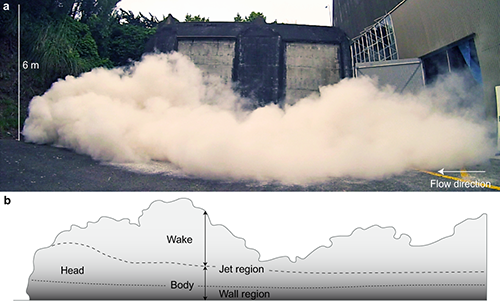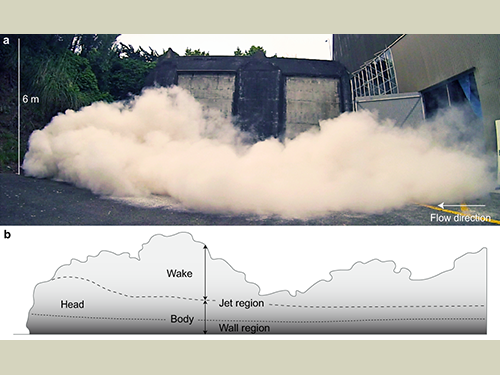Destructiveness of pyroclastic surges controlled by turbulent fluctuations

b)
Schematic sketch of the internal flow structure shown in Fig. 1a. This illustrates the longitudinal subdivision of the gravity current into the frontal head and trailing body regions; and the vertical structure of the gravity current where the rear of the head and the entire body region are overlain by the gravity current wake. The wide dashed line demarcates the position of the lower boundary of the wake. The narrow-dashed line delineates the position of the fastest velocity magnitude in vertical profiles through the current. This position separates the head and body regions into a lower layer dominated by shear with the solid lower flow boundary, which is often referred to as the wall region; and an upper region dominated by free shear, which is often termed the jet region. Figure 1 depicts the experimental surge during propagation across the unconfined runout section from c. 16–31 m from the impact zone. At this stage, partially buoyant plumes develop across the flow length, which continue rising as a phoenix cloud for tens of seconds after the cessation of forward motion of the experimental pyroclastic surge.
Brosch E., G. Lube, M. Cerminara, T. Esposti Ongaro, E.C.P. Breard, J. Dufek, B. Sovilla, L. Fullard (2021). Nature Communication, 12, 7306, https://doi.org/10.1038/s41467-021-27517-9
Abstract
Pyroclastic surges are lethal hazards from volcanoes that exhibit enormous destructiveness through dynamic pressures of 100–102 kPa inside flows capable of obliterating reinforced buildings. However, to date, there are no measurements inside these currents to quantify the dynamics of this important hazard process. Here we show, through large-scale experiments and the first field measurement of pressure inside pyroclastic surges, that dynamic pressure energy is mostly carried by large-scale coherent turbulent structures and gravity waves. These perpetuate as low-frequency high-pressure pulses downcurrent, form maxima in the flow energy spectra and drive a turbulent energy cascade. The pressure maxima exceed mean values, which are traditionally estimated for hazard assessments, manifold. The frequency of the most energetic coherent turbulent structures is bounded by a critical Strouhal number of ~0.3, allowing quantitative predictions. This explains the destructiveness of real-world flows through the development of c. 1–20 successive high-pressure pulses per minute. This discovery, which is also applicable to powder snow avalanches, necessitates a re-evaluation of hazard models that aim to forecast and mitigate volcanic hazard impacts globally.



Devi effettuare l'accesso per postare un commento.